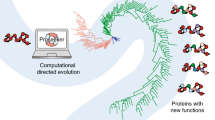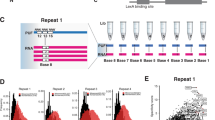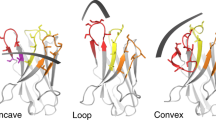Abstract
Natural nucleic acids frequently rely on proteins for stabilization or catalytic activity. In contrast, nucleic acids selected in vitro can catalyze a wide range of reactions even in the absence of proteins. To augment selected nucleic acids with protein functionalities, we have developed a technique for the selection of protein-dependent ribozyme ligases. After randomizing a previously selected ribozyme ligase, L1, we selected variants that required one of two protein cofactors, a tyrosyl transfer RNA (tRNA) synthetase (Cyt18) or hen egg white lysozyme. The resulting nucleoprotein enzymes were activated several thousand fold by their cognate protein effectors, and could specifically recognize the structures of the native proteins. Protein-dependent ribozymes can potentially be adapted to novel assays for detecting target proteins, and the selection method's generality may allow the high-throughput identification of ribozymes capable of recognizing a sizable fraction of a proteome.
This is a preview of subscription content, access via your institution
Access options
Subscribe to this journal
Receive 12 print issues and online access
$209.00 per year
only $17.42 per issue
Buy this article
- Purchase on Springer Link
- Instant access to full article PDF
Prices may be subject to local taxes which are calculated during checkout






Similar content being viewed by others
References
Kumar, S., Ma, B., Tsai, C.J., Wolfson, H. & Nussinov, R. Folding funnels and conformational transitions via hinge-bending motions. Cell Biochem. Biophys. 31, 141–164 (1999).
Ackers, G.K. Deciphering the molecular code of hemoglobin allostery. Adv. Protein Chem. 51, 185–253 (1998).
Tang, J. & Breaker, R.R. Rational design of allosteric ribozymes. Chem. Biol. 4, 453–459 (1997).
Robertson, M.P. & Ellington, A.D. Design and optimization of effector-activated ribozyme ligases. Nucleic Acids Res. 28, 1751–1759 (2000).
Koizumi, M., Soukup, G.A., Kerr, J.N. & Breaker, R.R. Allosteric selection of ribozymes that respond to the second messengers cGMP and cAMP. Nat. Struct. Biol. 6, 1062–1071 (1999).
Kurz, J.C. & Fierke, C.A. Ribonuclease P: a ribonucleoprotein enzyme. Curr. Opin. Chem. Biol. 4, 553–558 (2000).
Schön, A. Ribonuclease P: the diversity of a ubiquitous RNA processing enzyme. FEMS Microbiol. Rev. 23, 391–406 (1999).
Lambowitz, A.M., Caprara, M.G., Zimmerly, S. & Perlman, P.S. Group I and group II ribozymes as RNPs: clues to the past and guides to the future. In The RNA world. Edn. 2. (eds Gesteland, R.F., Cech, T. & Atkins, J.F.) 451–485 (Cold Spring Harbor Laboratory Press, Cold Spring Harbor, NY; 1999).
Weeks, K.M. & Cech, T.R. Protein facilitation of group I intron splicing by assembly of the catalytic core and the 5′ splice site domain. Cell 82, 221–230 (1995).
Weeks, K.M. & Cech, T.R. Assembly of a ribonucleoprotein catalyst by tertiary structure capture. Science 271, 345–348 (1996).
Weeks, K.M. Protein-facilitated RNA folding. Curr. Opin. Struct. Biol. 7, 336–342 (1997).
Coetzee, T., Herschlag, D. & Belfort, M. Escherichia coli proteins, including ribosomal protein S12, facilitate in vitro splicing of phage T4 introns by acting as RNA chaperones. Genes Dev. 8, 1575–1588 (1994).
Herschlag, D., Khosla, M., Tsuchihashi, Z. & Karpel, R.L. An RNA chaperone activity of non-specific RNA binding proteins in hammerhead ribozyme catalysis. EMBO J. 13, 2913–2924 (1994).
Herschlag, D. RNA chaperones and the RNA folding problem. J. Biol. Chem. 270, 20871–20874 (1995).
Robertson, M.P. & Ellington, A.D. In vitro selection of an allosteric ribozyme that transduces analytes to amplicons. Nat. Biotechnol. 17, 62–66 (1999).
Sargueil, B., Pecchia, D.B. & Burke, J.M. An improved version of the hairpin ribozyme functions as a ribonucleoprotein complex. Biochemistry 34, 7739–7748 (1995).
Soukup, G.A. & Breaker, R.R. Nucleic acid molecular switches. Trends Biotechnol. 17, 469–476 (1999).
Saldanha, R., Ellington, A. & Lambowitz, A.M. Analysis of the CYT-18 protein binding site at the junction of stacked helices in a group I intron RNA by quantitative binding assays and in vitro selection. J. Mol. Biol. 261, 23–42 (1996).
Garriga, G. & Lambowitz, A.M. Protein-dependent splicing of a group I intron in ribonucleoprotein particles and soluble fractions. Cell 46, 669–680 (1986).
Caprara, M.G., Mohr, G. & Lambowitz, A.M. A tyrosyl-tRNA synthetase protein induces tertiary folding of the group I intron catalytic core. J. Mol. Biol. 257, 512–531 (1996).
Soukup, G.A. & Breaker, R.R. Engineering precision RNA molecular switches. Proc. Natl. Acad. Sci. USA 96, 3584–3589 (1999).
Robertson, M.P., Hesselberth, J.R. & Ellington, A.D. Optimization and optimality of a short ribozyme ligase that joins non-Watson–Crick base pairings. RNA 7, 513–523 (2001).
Ahern, T.J. & Klibanov, A.M. The mechanisms of irreversible enzyme inactivation at 100°C. Science 228, 1280–1284 (1985).
Fischer, B., Sumner, I. & Goodenough, P. Analysis of catalytic properties of hen egg white lysozyme during renaturation from denatured and reduced material. Arch. Biochem. Biophys. 298, 361–364 (1992).
Cox, J.C. & Ellington, A.D. Automated selection of anti-protein aptamers. Bioorg. Med. Chem. in press.
Myers, C.A. et al. A tyrosyl-tRNA synthetase suppresses structural defects in the two major helical domains of the group I intron catalytic core. J. Mol. Biol. 262, 87–104 (1996).
Loria, A., Niranjanakumari, S., Fierke, C.A. & Pan, T. Recognition of a pre-tRNA substrate by the Bacillus subtilis RNase P holoenzyme. Biochemistry 37, 15466–15473 (1998).
Biswas, R., Ledman, D.W., Fox, R.O., Altman, S. & Gopalan, V. Mapping RNA–protein interactions in ribonuclease P from Escherichia coli using disulfide-linked EDTA-Fe. J. Mol. Biol. 296, 19–31 (2000).
Niranjanakumari, S., Stams, T., Crary, S.M., Christianson, D.W. & Fierke, C.A. Protein component of the ribozyme ribonuclease P alters substrate recognition by directly contacting precursor tRNA. Proc. Natl. Acad. Sci. USA 95, 15212–15217 (1998).
Kurz, J.C., Niranjanakumari, S. & Fierke, C.A. Protein component of Bacillus subtilis RNase P specifically enhances the affinity for precursor–tRNAAsp. Biochemistry 37, 2393–2400 (1998).
Reich, C., Olsen, G.J., Pace, B. & Pace, N.R. Role of the protein moiety of ribonuclease P, a ribonucleoprotein enzyme. Science 239, 178–181 (1988).
Mendoza, L.G. et al. High-throughput microarray-based enzyme-linked immunosorbent assay (ELISA). Biotechniques 27, 778–780, 782–786, 788 (1999).
Borrebaeck, C.A. Antibodies in diagnostics—from immunoassays to protein chips. Immunol. Today 21, 379–382 (2000).
Holt, L.J., Büssow, K., Walter, G. & Tomlinson, I.M. By-passing selection: direct screening for antibody–antigen interactions using protein arrays. Nucleic Acids Res. 28, E72 (2000).
Hesselberth, J., Robertson, M.P., Jhaveri, S. & Ellington, A.D. In vitro selection of nucleic acids for diagnostic applications. J. Biotechnol. 74, 15–25 (2000).
Cox, J.C., Rudolph, P. & Ellington, A.D. Automated RNA selection. Biotechnol. Prog. 14, 845–850 (1998).
Jhaveri, S.D. & Ellington, A.D. In vitro selection of RNA aptamers to a protein target by filter immobilization. In Current protocols in nucleic acid chemistry. (eds Beaucage, S.L., Bergstrom, D.E., Glick, G.D. & Jones, R.A.) 9.3.1–9.3.25 (Wiley, New York, NY; 2000).
Heus, H.A. & Pardi, A. Structural features that give rise to the unusual stability of RNA hairpins containing GNRA loops. Science 253, 191–194 (1991).
Acknowledgements
We would like to thank Jay Hesselberth and Christopher Myers for providing purified Cyt18 protein, Jamie Bacher for providing E. coli TrpRS, and Colin Cox for supplying unpublished aptamer sequences. This work was supported by DARPA contract no. N65236-98-1-5413.
Author information
Authors and Affiliations
Rights and permissions
About this article
Cite this article
Robertson, M., Ellington, A. In vitro selection of nucleoprotein enzymes. Nat Biotechnol 19, 650–655 (2001). https://doi.org/10.1038/90256
Received:
Accepted:
Issue Date:
DOI: https://doi.org/10.1038/90256
This article is cited by
-
Synthetic RNA circuits
Nature Chemical Biology (2007)



